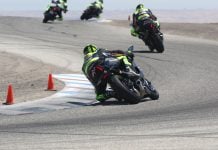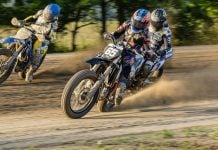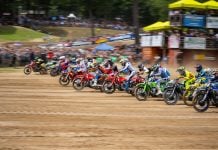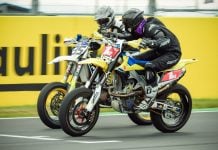By Peter Starr
Before GoPro…
It is easy to get jaundiced about today’s road racing coverage on television.The rapid progression of technology, including the gyro-stabilized MotoGP cameras, is simply amazing, and their size is miniscule.Yet, it was not so long ago, at least by the standards of people of my age, that we were strapping eight-pound film cameras on the side of Bell’s then quite new full-face Star helmet, and convincing the stars of the day like Barry Sheene, not just to wear it, but to chase the likes of Steve Baker around Mallory Park at close to racing speeds! Likewise Yvon Duhamel at the 24 hours of Le Mans and Roberto Pietri chasing Freddie Spencer at Daytona, and the list goes on.
Even though by 1985 we were filming races on video tape, portable, battery-powered video cameras were still gargantuan when compared to their equivalent today, so on-board shots were still shot on film, and inserted later.It was not until the Stroh Mile dirt track races in 1985 that we managed to get a live broadcast from a racing motorcycle, and even then the quality, compared to film, left a lot to be desired.That first live broadcast camera was placed on Ricky Graham’s bike at the Du Quoin Mile for ABC’s Wide World of Sports.
Bike-mounted cameras were hard to engineer since to avoid vibration the camera had to be hard-mounted on racing bikes. The speed, G-forces and the potential for danger if they ever came lose, presented a unique set of challenges.Film cameras are mechanical devices where the camera exposes film by physically passing it though a “gate” exposing it one frame at a time at a rate of 24 frames per second.On some of the most expensive cameras, like Photosonics, the process is aided by the application of a registration pin, which stabilizes the film as it is held in the gate as the film is exposed.However, for most of our filming for helmets and on-board bikes we used a cheap camera that we got from World War II and Korean War airplanes that were originally used to witness the firing of their guns, and recording their successes, or otherwise. We modified them to work in the almost equally hostile environment of motorcycle racing.
The first time a film camera was allowed on a racing motorcycle during an actual National race was at Laguna Seca in 1980.The mounts were built at Formula 1 racing legend Dan Gurney’s shop on a bike provided by Cycle Tunes’ Dennis Smith. David Emde rode the bike and every 11 minutes during the race, he would pull into the pits for us to change the 400-foot film magazine loads. He would then wait until the leaders came around again, and rejoined the race.
The length of film we could carry on a bike was always the defining issue of how we were going to make the film.On Mike Hailwood’s bike in the Isle of Man in 1977, Kel Carruthers built a special platform to the fairing of the bike to accommodate an eight-pound film camera that would carry a 100-foot load lasting about three minutes. The camera was an N9 from a Korean War-vintage fighter aircraft. The problem was that in 1977 a lap of the Island took over 20 minutes and we did not want to interrupt Hailwood’s ride with seven stops, so we chose the areas we really needed to film and he only stopped twice, once at Ballacraine after the first three minutes of the ride and once at Parliament Square, Ramsey prior to tackling the Mountain.
I look back with some considerable pride at what we accomplished in those days with such crude tools. But I do envy the ease and convenience that “point-of-view” footage is gathered today, thanks to GoPro and similar cameras.
About Peter Starr
Over two decades starting in 1973, Peter Starr made over 40 films about motorcycle sport, the most famous being his multi-award-winning “Take It To The Limit.” Currently Starr has a large-format, coffee-table book on the market that is prime material for a Christmas present for any motorcycle racing enthusiast. The book, which comes with a DVD containing eight of Starr’s favorite film sequences–including the famous Mike Hailwood lap of the Isle of Man and the epic battle between Freddie Spencer, Mike Baldwin and Kenny Roberts in the 1982 Daytona 200–thoroughly documents those 20 years. Starr provides details of working with some of the greatest motorcycle racers of that era including Kenny Roberts, Mike Hailwood, Barry Sheene, Steve Baker, Roger DeCoster, Russ Collins and many more. The 270-page book has over 500 photographs and normally sells for $49.95 plus $7.50 shipping. For a limited time Roadracing World readers can get the book for the special holiday price of $39.95, including the shipping!
Just copy and paste this link into your browser and enjoy!
http://motodvd.com/index.php?route=product/product&product_id=58&search=taking+it






